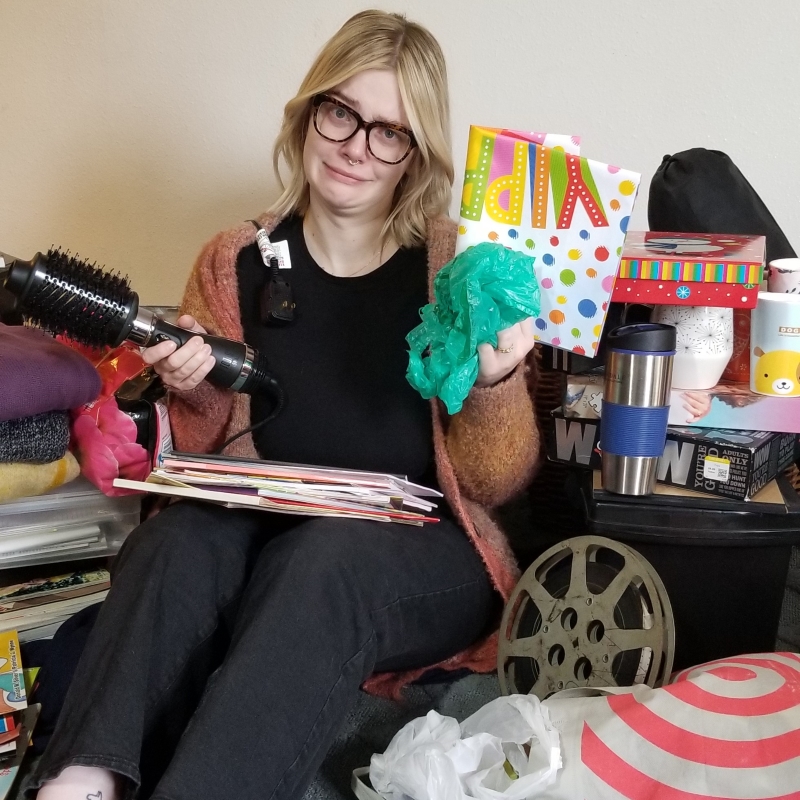
Ever feel like you just have too much stuff?
This Thursday, November 16, is the unofficial (should be official) holiday of using less stuff and creating less waste, aptly named Use Less Stuff Day. Created to inspire folks to cut down both on how much they are consuming and how much they are throwing away, the concept behind the day is especially important as we head into the holiday season, a time of year well known for increasing both. With that in mind, we’ve put together a list of easy, environmentally friendly changes you can make to live more sustainably throughout the holidays and beyond. (All it takes is a little extra attention paid to our three favorite R’s—reducing, reusing, and recycling!)
For Gift Giving
Gift experiences: Know a friend who loves music? Or rock climbing? Or hiking? Maybe they’d love a chance to get their hair done? 😜 Why not make a gift out of it? Experiences are an underrated yet wonderful option for a present, because they provide a thoughtful gift tailored to the specific person's interests or needs without requiring a tangible something be given that they’ll need to make space for later. Even better is that many of these can be delivered as eGift cards, which are a fast, convenient, earth-friendly, AND clutter-free way to give a gift. An honest and true DREAM for the Use Less Stuff spirit!
Make it homemade: Alternatively, perhaps you have the skill to create something they need—let’s say you are an experienced woodworker and they’ve mentioned needing shelves, or you love baking and know they’d enjoy some freshly made bread. There are lots of ways to give a meaningful gift that don’t require buying something new. To be sure, sometimes these gifts are the most appreciated because of the extra time, thought, and effort that goes into making them.
Make it reusable: Encourage your loved ones to be more mindful of how they consume by giving gifts that make it easier for them to do so. If you have a friend who loves eating out, a reusable set of utensils is great. For the person in your life who loves coffee, a bag of fair-trade beans or a travel tumbler is perfect. And since we’ve all found ourselves realizing we’ve forgotten our reusable shopping tote while in the checkout line at one time or another, these bags, made by a fellow B Corp®, fold up to about the size of a wallet and can be stored in the bag you already carry with you daily.
What’s in the wrap?: If you are giving a physical gift (and there’s nothing wrong with that!), put some thought into what you’re using for wrap. Why not give it in something the recipient will be able to use again later? Reusable bags, fabric wraps, and containers all work really well and look cute too. If paper is your jam, ensure it is at least recyclable, or even better, biodegradable!
For Everyday Differences
Embrace reusable shopping bags: We know, we know. These are the bane of most everyone’s sustainable intentions. We love that you have roughly 10,000 of these stocked up at home, waiting for their shining moment. We know that every. dang. time you go to the grocery store, you tell yourself, “This is the day!” only to realize, upon reaching check out, you have, in fact, forgotten them (again). We know you mentally curse bags everywhere each time you buy another one. We know. So, here’s what we’re saying: You’re thinking about it now. If nothing else, make today THE DAY that you actually move that stock of bags to your car or near the door or place one into the bag you bring with you anyway to be ready for when you need it. Do it now.
Invest in sustainable products: The products we use on our hair, bodies, clothing, and households can make an impact. Look for products that are made using sustainable practices and ingredients and minimize the use of plastic. We love these shampoo bars, sold in all of our salons, because they are manufactured with the Earth in mind and don’t utilize any plastic at all.
Reconsider single-use items: From eating utensils to straws, cups to bottled water it seems like there is a single-use option for everything. But what happens to them after that use? Often, they are thrown out, eventually ending up in landfills where they just… sit. Other times, they end up on the side of the road, in the ocean, and clogging up waterways. No, thank you. Invest in a reusable water bottle you can use instead of buying it while you’re on the go. If you’re buying your friends a set of utensils for eating out, gift yourself some too. Helping the environment AND you’re always ready for a snack? That sounds like a real win to us.
If it ain’t broke, don’t replace it!: So much of what we accumulate is simply the result of buying something new simply for the thrill of it being new. Phones, appliances, clothing; many times we are replacing items we own that are still perfectly adequate and capable of meeting our needs. Rather than jumping up to upgrade because you can, consider if the upgrade is actually something you need—Is your current item broken in some way or no longer doing the job for which it was purchased? Does the newer version offer something your current one doesn’t that is necessary for your everyday existence? Will buying it genuinely and significantly improve your life? If the answer is no, ask yourself if replacing it is really necessary or worth it long term.
Think before you buy: Okay, so you’re about to make/create/bake/invent something a little out of the ordinary, which is AWESOME, only you hit a snag during the planning stages when you realize there is a specific piece of equipment you need and don’t currently have. Bummer.
WAIT. We can feel you mentally prepping to order one asap. But before you do, take a minute and consider the following:
–Outside of this one use, how likely am I to use the item again?
–Is there any way to complete this project without the item/Do I have something around my house that would work instead?
–Do I know someone or have a friend who has this item and would let me borrow it?
–Is this item essential to my daily life and living?
If it isn’t an item that will be integral to your life or used often, make buying it a last resort. That way, you won’t end up with a bunch of stuff stuffed in your closet, staring at you every time you open the door.
On the other hand, other times, we’re buying on impulse, not because we need it, but because it is pretty cool or cute and we are already here so hey, why not? This is a great time to do a quick check-in with yourself (much like when you were considering the upgrade!): Is this a necessity or a want? Do I already own something similar that would serve the same purpose? Move away from impulsive buying to a more thoughtful purchasing experience.
Repurpose it: What do you already own that, given the opportunity, could suit another purpose? Jars can become planters, paper towel rolls can be used to organize cords (and wrapping paper, actually), gift boxes can be turned into storage bins. With a little imagination, you’ll be surprised at how much you can do with what you already have!
Sell/Donate it: Too often, when we no longer want or need something, our knee-jerk reaction is to simply toss it away, even if it is in fine working order. But why? There are a host of folks who might be looking for exactly that thing, who would be more than willing to give it a new home. Before tossing it, ask those in your social circle if they have a use for it, see if you can donate it to organizations that help those in need, or even try to sell it yourself to make some extra cash (which is always helpful during the holiday season). Not only does this keep items out of landfills, it also reduces the impact of continually buying new.
Recycle it: If the item is no longer workable or in a condition to be sold or donated, see if it can be recycled. Many items such as electronics and batteries can be recycled at specialty areas around town. If you don’t want to make the trip for only one or two items, why not put out a call to friends, family, or the community, letting them know you are planning on making a trip and seeing if they have anything they need to recycle? (We love a community-building moment.) This can help reduce any associated costs as well.
Remember, the idea behind using less isn’t living without; it’s simply refocusing our attention as consumers and reducing waste in an effort to do better for our world. If something is absolutely a necessity, get it! If it isn’t, skip it, and have fun seeing what you can create (or recreate) with the things you already have.
And hey, Use Less Stuff Day may only last for 24 hours, but why not extend it for a week after? If that’s doable, why not the month? Challenge yourself to make using and accumulating less stuff a part of your daily routine every day. You’ll be amazed at how much you can do for your space and the Earth.
P.S. Finding places to make donations or take recyclables can be daunting. Here are a few of our favorites to get you started:
Community Warehouse–Mattresses, linens, kitchenware, small appliances, and more
Free Geek–Electronics, cables and cords, computers, phones
Habitat for Humanity's ReStore–Lawn and garden supplies, building materials, furniture, and more
ReBuilding Center–Furniture, building materials, and more
Rose Haven–Sleeping bags, backpacks, select clothing and hygiene items
SCRAP–Art supplies, craft supplies, gift wrap, party supplies, fabric yardage, and more
